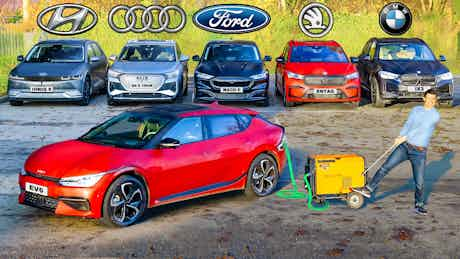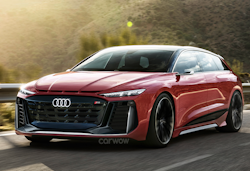Electric cars put to the ultimate range test
December 23, 2021 by carwow staff

Kia vs BMW vs Skoda vs Ford vs Audi vs Hyundai
One of the most important things to consider if you’re looking to buy an electric car is its range – how far you can drive on a single charge. To find out which of the latest and greatest electric cars can go the farthest, we drove a Kia EV6, BMW iX3, Skoda Enyaq, Ford Mustang Mach-E, Audi Q4 E-Tron and a Hyundai Ioniq 5 until their batteries died.
Watch the video below to see how these cars fared in carwow’s ultimate electric car range test.
Before the test, each car was charged up to 100% full and left parked overnight. This means they started the test having lost a few percent each, but all six were at least 95% fully charged before they set off.
To make it as scientific as possible, each car was driven in a similar way on exactly the same route – starting at a service station on the outskirts of London before heading north on the M1 motorway. Each car only peeled off the motorway when it was about to run out of charge.
First up, let’s take a look at the Kia EV6. It has a 78kWh battery pack and dual motors providing all-wheel-drive. It weighs in at just over two tons and has a claimed range of 303 miles. We have the GT Line S trim, which will set you back just over £50,000.
Next we have the BMW iX3. It has a 74kWh battery pack and rear wheel drive. It tips the scales at 2,255kg and has a claimed range of 281 miles. The BMW has 286hp and will set you back £60,000.
The Skoda Enyaq has a 77kWh battery pack which Skoda claims will give it a range of 303 miles. It has 265hp and all-wheel-drive, which is the best you can get until the vRS version comes along. This model will set you back £50,000.
Moving on to the Ford Mustang Mach-E, it has the smallest battery here at 70kWh which Ford claims will give it 273 miles of range. The model we have here is the Standard Range rear-wheel-drive with 269hp and it weighs just under two tons. This car will cost you £41,330.
Up next we have the Audi Q4 E-Tron. It has a 76.6kWh battery and all-wheel drive, giving it a claimed range of 298 miles. It weighs in at around 2.1 tons and has 229hp. The model we have here will set you back around £63,000.
Last but not least, we have the Hyundai Ioniq 5. This funky looking EV has a 73kWh battery and all-wheel-drive. Hyundai claim it will do 285 miles on a single charge. The model we have has 305hp and will set you back £46,000.
You can see the results of this test in the table below:
| Make and model | Range test achieved (Miles) | WLTP Claimed range (miles) | Percentage of claimed range achieved |
| Kia EV6 | 273 | 303 | 91 |
| BMW iX3 | 257 | 281 | 91 |
| Skoda Enyaq | 264 | 303 | 87 |
| Ford Mustang Mach-E | 228 | 298 | 83 |
| Hyundai Ioniq 5 | 237 | 285 | 83 |
| Audi Q4 E-Tron | 234 | 298 | 78 |
Renault vs Vauxhall vs Volkswagen vs Peugeot vs Mini vs Honda
This isn’t the first time we’ve tested EVs to their limits. Last year we put a group of electric superminis through their paces to see which would go the furthest. You can see the results of that test below.
| Make and model | Range test achieved (miles) | WLTP claimed range (miles) | Percentage of claimed range achieved |
| Renault Zoe | 229 | 238 | 96% |
| Vauxhall Corsa e | 174 | 209 | 83% |
| Volkswagen e-Up | 162 | 159 | 102% |
| Peugeot e-208 | 162 | 217 | 74% |
| Mini Electric | 154 | 145 | 106% |
| Honda e | 113 | 125 | 90% |
If you look at distance travelled as a percentage of claimed range, the Peugeot e-208 was the worst-performing car in the test. It chalked up 162 miles, which is 74% of Peugeot’s claimed 217-mile range. It’s still a fair figure in terms of outright range, however, and places the Peugeot mid-field in our list of total miles driven.
Interestingly, both the VW e-Up and Mini Electric managed to better their claimed ranges by 2% and 6% respectively. The e-Up managed 162 miles compared with its claimed 159-mile range, while the Mini topped its official 145-mile range by a total of nine miles.
In terms of total distance driven, however, the clear winner was the Renault Zoe. Despite being one of the most affordable electric cars on sale, it managed an impressive 229 miles on a single charge, which is 96% of its claimed 238-mile range.
Interestingly, this means the dinky Zoe outperformed a number of much larger, much more expensive cars that we tested in 2019, including the Mercedes EQC and Audi e-tron. These models were driven on a very similar route in an identical manner. Watch the video below to see the results of that test.
Tesla vs Kia vs Jaguar vs Nissan vs Audi vs Mercedes
Just like in our latest electric-car range test, these cars were charged up and left overnight, before being driven north on the M1.
| Make and model | Range test achieved (miles) | WLTP claimed range (miles) | Percentage of claimed range achieved |
| Tesla Model 3 | 270 | 348 | 78% |
| Kia e-Niro | 255 | 282 | 90% |
| Jaguar I-PACE | 223 | 292 | 76% |
| Nissan Leaf | 208 | 239 | 87% |
| Audi e-tron | 206 | 255 | 81% |
| Mercedes EQC | 194 | 259 | 75% |
While the Tesla Model 3 comfortably logged the most miles it was the Kia e-Niro which was the most impressive in terms of the percentage of its claimed range achieved, completing 255 miles on a full charge, 90% of the claimed 282-mile range.
We’ve also put the all-new VW ID.3 to the test, driving it from fully charged until its batteries were completely flat. Watch the video below to see how it fared.
The ID.3 is VW’s first purpose-built electric car and it comes with a claimed 263 miles of range. In our test – which was performed over a different route to the two tests above but driven in a similar manner – it managed 224 miles on a single charge. This works out as just over 85% of its claimed range – a respectable score when you compare it to the other cars we’ve tested.
Mat Watson, Car Expert at carwow said: “Despite one test ending with me being questioned by a concerned member of the public as to why I was circling a charging point for over an hour in the dark it was great fun and hugely revealing.”
While ‘range anxiety’ is a concern for some people thinking about switching from petrol to electric, our test showed that every electric car we tested was able to keep going after their systems claimed their batteries were totally flat.















